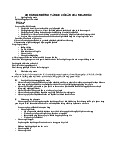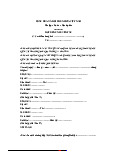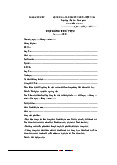




Preview text:
TASK SHEET 6: SYNTHESIZING & REFERENCING PRACTICE 1
Read the articles below and, in a paragraph of not more than 250 words, answer the
question: How many languages are there in the world? Using in-text citations and
references following APA style.
First use these guiding questions to support your writing.
1. Which article can be used to set the background that the number of languages
spoken in the world is unidentified? Write one sentence.
Ko xd bnhiu nn vi the gioi k xac dinh voi nhau ntn la ngon ng
2. According to article 2, what makes people speak differently? Write one or two sentences.
Speaker idolect base on heath sex region size ca nhan + ca nha
Group + group ( social + geograph)
3. Do article 3 and article 4 share the same view? Write one or two sentences to
show the agreement or disagreement between the 2 articles. SAME VIEW
NN O NHUNG NOI GIAO NHA => TAO RA NN CHUNG
pp from 2 coutries livig close to the bouderline still understand the languge of ech other
Same countries speaking difrend dialect don understan eachorther
4. Now put all of the sentences together in one paragraph that answers the
question. Add transition words to make your ideas logical. Add a meaningful concluding sentence.
According to Crystal, many languages were not identified because people don't
have specific definitions of what the language is (1987, p. 284). To support
Crystal’s view, Fromkin and Rodman said that the speaker's idiolect depends on
what situation people are in (age, sex & size). In addition, It may change between
regions and society ( voice, accent & the local languages) (1983, p.245).Lyons
(1968) state that people who live close to the boundary still understand
languages each other. Disgree with Lyons view, 5. Check the use of citation. 6. Make a reference list. ……..
1. There is no agreed total for the number of languages spoken in the world today.
Most reference books give a figure of 4,000 to 5,000, but estimates have varied
from 3,000 to 10,000. To see why there is such uncertainty, we need to consider
the many problems facing those who wish to obtain accurate information, and
also the reasons (linguistic, historical and cultural) which preclude a simple
answer to the question "What counts as a language?"
(Written by David Crystal, on page 284 of The Cambridge encyclopaedia of language. It
was published by Cambridge University Press, in Cambridge, UK, in 1987)
2. All speakers of English can talk to each other and pretty much understand each
other. Yet no two speakers speak exactly alike. Some differences are due to
age, sex, state of health, size, personality, emotional state and personal
idiosyncrasies. That each person speaks somewhat differently from all others is
shown by our ability to recognise acquaintances by hearing them talk. The
unique characteristics of the language of an individual speaker are referred to as
the speaker's idiolect. English may then be said to consist of 400,000,000
idiolects, or the number equal to the number of native speakers.
Beyond these individual differences, the language of a group of people may
show regular variations from that used by other groups of speakers of that
language. When the English spoken by speakers in different geographical
regions and from different social groups shows systematic differences, the
groups are said to speak different dialects of the same language. The dialects of
a single language may thus be defined as mutually intelligible forms of that
language which differ in systematic ways from each other.
(From: An introduction to language, by Victoria Fromkin and Robert Rodman. The book
was written in 1983 and was published by Holt-Saunders in New York. The extract comes from page 245.)
3. A further point that has become clear as a result of the investigation of regional
dialects is the impossibility of drawing a sharp line of demarcation between
dialects of the same neighbouring languages. In those areas of the world where
there have been frequent changes of political boundaries or where the principal
lines of trade and communication cross political boundaries, what is generally
regarded as a dialect of one language may shade more or less imperceptibly into
a dialect of another. For example, there are dialects spoken on both sides of the
Dutch-German border which are equally close to (or equally remote from) both
standard Dutch and standard German. If we feel that they must be dialects of
either the one or the other language, we are victims of the traditional view of the
relationship between language and dialect. It may be added that judgements on
questions of this kind are only too frequently influenced by political or nationalist prejudices.
(From John Lyons: Introduction to theoretical linguistics, published in 1968 by
Cambridge University Press in Cambridge. The extract can be found on page 35.)
4. It should also be made clear here that, mutual unintelligibility is not evidence that
the "native" language or mother tongue of two speakers is not the same. For, as
in the case of Mandarin, Chung King and Cantonese dialects of Chinese, and
many dialects of Arabic, it is entirely possible that people can be native speakers
of the same language and yet not understand each other.
(From: An introduction to language and communication, page 137. This book was
published in 1994 by MTI Publications. It was published in Cambridge, UK and was
written by Ashley James, Jane Richards and Harry Roberts.) PRACTICE 2
Read the articles below and, in a paragraph of not more than 250 words,
discuss the advantages and disadvantages of globalisation.
1. Globalisation is the tendency for the world economy to work as one unit,
led by large international companies doing business all over the world.
Some of the things that have led to globalisation are the ending of trade
barriers, the free movement of capital, cheap transport and the
increased use of electronic systems of communication such as the Internet.
(From: Longman business English dictionary, published in London by Longman in 2000.)
2. These new channels of communication have helped spread a
homogenous and largely commercial culture. Disney movies are
children's food the world over. Barbie dolls, fast-food restaurants, hip-
hop music and corporate-driven, American-style youth culture attract
millions of new converts from the bidonvilles of Abidjan, Côte d'Ivoire, to
the wealthy suburbs of Sydney. Alternatively, you can now find a
dazzling variety of 'ethnic' foods - including Thai, Szechwan, Mexican
and Indian - throughout Europe, North America and Australia. In fact,
many residents and visitors to Britain believe globalisation and the
resulting 'fusion' of cuisine is the best thing to happen to English
cooking in the past 500 years.
There is every reason to believe this global exchange of people,
products, plants, animals, technologies and ideas will continue into the
future. The process of change is unstoppable. And that is not such a
bad thing. In many ways it is a positive process containing the seeds of
a better future for all the world's people. Globalisation cannot help but
be a positive force for change if we come to recognize the common
thread of humanity that ties us together.
However, gaps between rich and poor are widening, decision-making
power is concentrated in fewer and fewer hands, local cultures are
wiped out, biological diversity is destroyed, regional tensions are
increasing and the environment is nearing the point of collapse. That is
the sad reality of globalisation, an opportunity for human progress
whose great potential has been thwarted. Instead we have a global
economic system which feeds on itself while marginalizing the
fundamental human needs of people and communities.
(From an article by David Ransome called Globalisation - an alternative view.
It was in the magazine: New Internationalist, in 1997. It was in volume 296,
and the article was on pages 7-10. This quotation was from page 8.)
3. Globalisation is a new word that describes an old process: the
integration of the global economy that began in earnest with the launch
of the European colonial era five centuries ago. But the process has
accelerated over the past quarter century with the explosion of
computer technology, the dismantling of trade barriers and the
expanding political and economic power of multinational corporations.
(This is from a book called: The no-nonsense guide to globalisation by Wayne
Ellwood. It was published in London by Verso in 2001. The quotation is from page 12.)
4. Globalisation is increasing inequality and poverty worldwide as national
governments lose the ability to control their development strategies and
policies. Political solutions are needed to reinvigorate democratic
control both North and South. But political reforms need to be combined
with particular mechanisms for structural reform. In combination these
should put meaningful employment and human rights at the heart of
economic policy, boost local control and decision-making, and restore
the ecological health and natural capital of our planet.
(This is also from: The no-nonsense guide to globalisation. This quotation is from page 107.) Guides for writing
1. Step 1: Reading. Use three different highlighters for definition, advantages and
disadvantages of globalization. Only highlight keywords.
2. Step 2: Note-taking. Group the ideas of the same categories, i.e., definition,
advantages, and disadvantages. Don’t forget to note the sources of the ideas. Notes - Globalization Definition … Advantages … Disadvantage …. s
3. Step 3: Writing. Now combine the ideas together, using paraphrasing,
summarizing and quotation (sparsely) with appropriate APA in-text citation. Add
transition words to make your ideas logically. Then, add a meaningful concluding sentence.
4. Step 4: Proofread and make a reference list.




